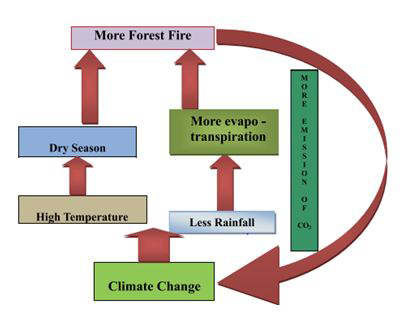| Demand of the question Introduction. Contextual Introduction. Body. Reasons of forest fires and its Impact. Measures for tackling forest fires. Conclusion. Way forward. |
Forest fire is the uncontrolled fire that destroys large parts of the forest. They are a threat to the fauna and flora and destroy the biodiversity and the ecology of a region. Forest fire causes imbalances in nature and endangers biodiversity by destroying habitats and precious life. Incidents of forest fires have increased in recent years. The main reason for this is climate change fuelled by anthropogenic activity. About 21.40% of forest cover in India is prone to fires according to a 2019 report by the Forest Survey of India that demand urgent action.
Causes of Forest Fires:
| Anthropogenic causes (90% of all wildfires) | Natural Causes |
| Smoking: Smoking is the leading cause of fires and deaths globally. Habit of smoking while driving, walking or biking and then throwing away the cigarette butts without completely extinguishing it lead to forest fires. Smokers at times become negligent at extinguishing the cigarette butts after smoking.
| Lightning: A good number of wildfires are triggered by lightning. A lightning strike can produce a spark. Sometimes the lightning can strike power cables, trees, or rocks and any other thing and this can trigger a fire.
|
| Campfires: During camping or outdoor activities people normally leave lit fires or combusting materials unattended to which ignite wildfires. It is a must for all lit fires and combusting materials to be totally extinguished after use to avoid wildfire disasters. | Volcanic eruption: Hot magma in the earth’s crust is usually expelled out as lava during a volcanic eruption. The hot lava then flows into nearby fields or lands to start wildfires. |
| Burning Debris: Wastes and trash are on several occasions burned to ashes as a way of reducing the accumulation of rubbish. What is left after burning the waste matter or trash is debris that burns slowly. This slowly burning debris can potentially set anything ablaze and start a wildfire because of the heat. | Heat patterns: Increased temperatures due to global warming are making the forests more vulnerable. Rising atmospheric temperatures and dryness (low humidity) make favorable circumstances for a fire to start. |
| Fireworks: Fireworks are used by humans for various reasons such as festivals. However, their explosive nature can start wildfires. |
Impact of forest fires on ecosystems:
- Loss of Ecosystems and Biodiversity: Forest fires destroy the habitats and the intricate relationships of diverse flora and fauna leading to loss of ecosystems and biodiversity.
- Wildfires damage the habitable and adaptable land for specific animal and plant species.
- Besides, wildfires can even lead to extinction for certain animals.
- Wildfires can be so severe that they decimate the habits and critical relationships of plants and animals causing loss of ecosystem.
- Forest Degradation: Forest fires especially that commonly happen in dry tropical forests are a major cause of forest degradation. Almost every year, forest fires are witnessed across different forest regions which persistently reduce the quality of certain forest features like soil fertility, biodiversity, and ecosystems.
- Air Pollution: Living plant matter purifies the atmospheric air we depend on for respiration. They achieve this by taking in carbon dioxide, greenhouse gases, and air impurities and by producing oxygen. In addition, the huge clouds of smoke instigated by wildfires lead to massive air pollution.
- Global Warming: When plant life is exterminated by fires, the quality of air we breathe in declines and greenhouse gasses increase in the atmosphere leading to climate change and global warming. Trees and vegetation when are burned, it means more greenhouse gases increases in the atmosphere, resulting in global warming
- Soil Degradation: Forest soils are loaded with nutrients released from decaying forest debris. Forest fires kill beneficial soil microorganisms that are responsible for breaking down the soil and promoting soil microbial activities. The burning of trees and vegetation cover also leaves the soil bare making it readily vulnerable to soil erosion.
- Destruction of Watersheds: Trees and vegetation cover acts as watershed protectors since approximately all the water comes from forest-derived water tables. Whenever they burn, the natural protection systems for water tables, streams, and rivers may be affected.
Measures to prevent forest fires:
- Policy: A national policy is required to consolidate existing guidelines and to issue comprehensive guidelines which should be aligned with the climate change policies. The policy should also define the respective roles and responsibilities of the MoEFCC, state forest departments, and disaster agencies, and establish a mechanism for the provision of regular funding to the states.
- Human Capital: Ground-based detection will continue to be essential along with the introduction of new remote sensing technologies. So, training should be provided to field officers, seasonal fire watchers, and community volunteers involved in firefighting.
- Coordination with other agencies: Stronger collaboration between the State Forest Departments (SFDs), the disaster management authorities and research entities would enable states to innovate new science-based management approaches for preventing fires and rehabilitating fire-affected areas.
- Technology: Systems for early warning and fire danger need to be developed. Fire alert systems can also be improved by integrating ground-based detection with the satellite-based alert systems.
- Community Engagement: Sensitisation of communities should be done to ensure that fire is used responsibly in a way that promotes forest health, while seeking to avoid damaging and out-of-control fires.Provision of training should extend beyond state-managed forests to community institutions in regions such as the Northeast, where communities are responsible for managing most of the forest estate.
Forest fires incidents have increased due to global warming. Destruction of forests is a crisis and need immediate action. Fast initial attack measures are required with a vigorous follow up action. Special emphasis should be given to research, training, and development.






